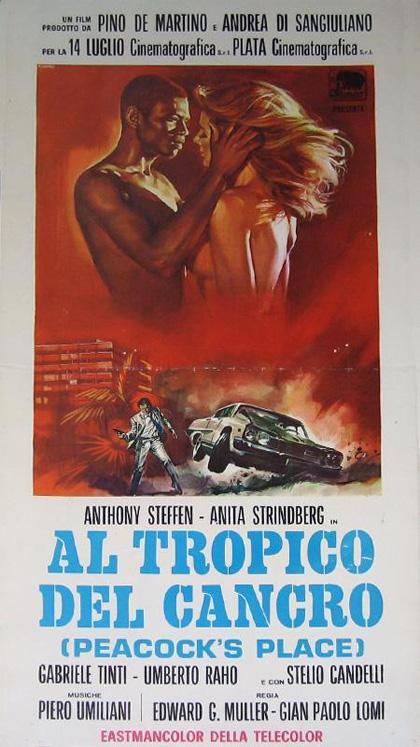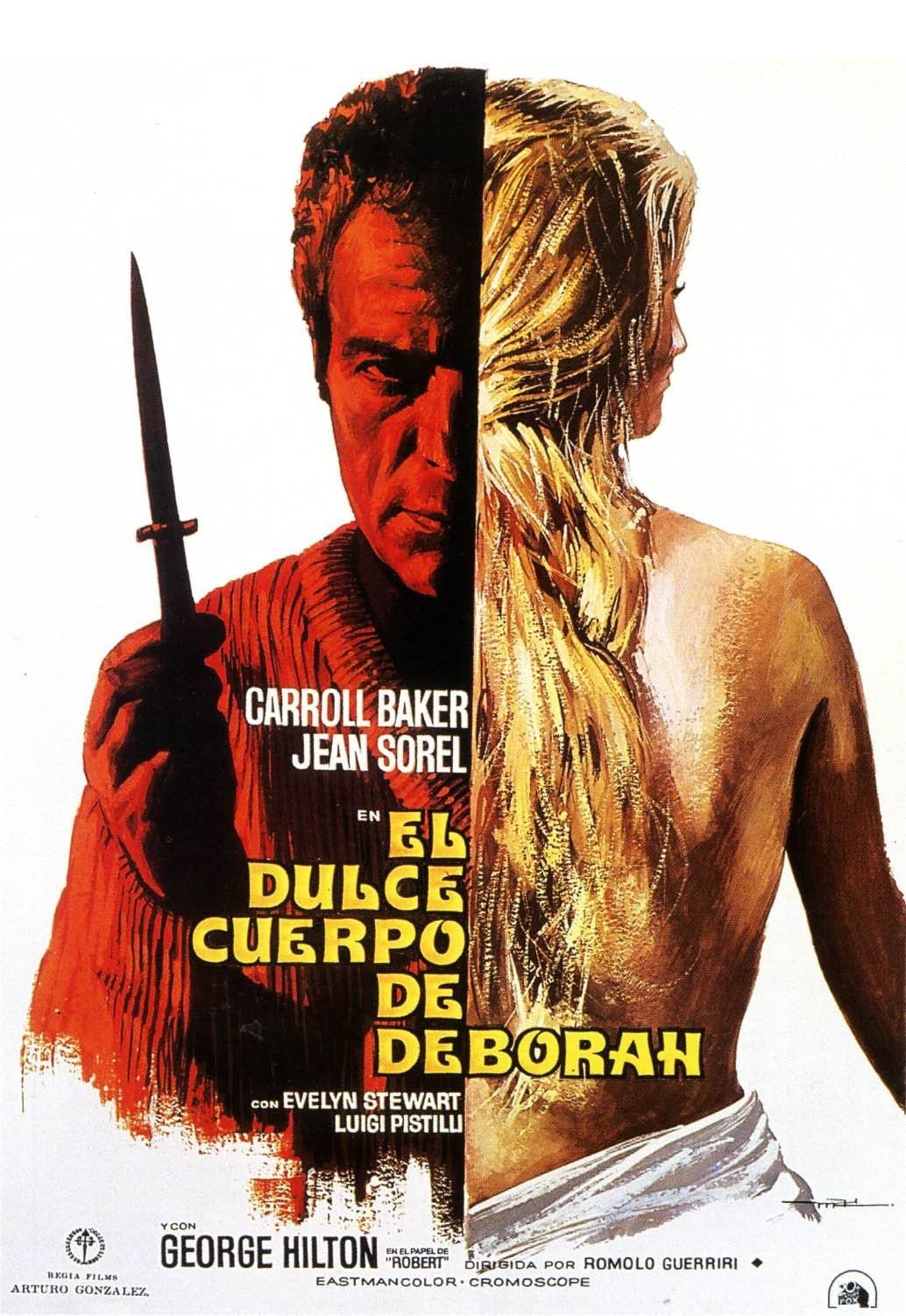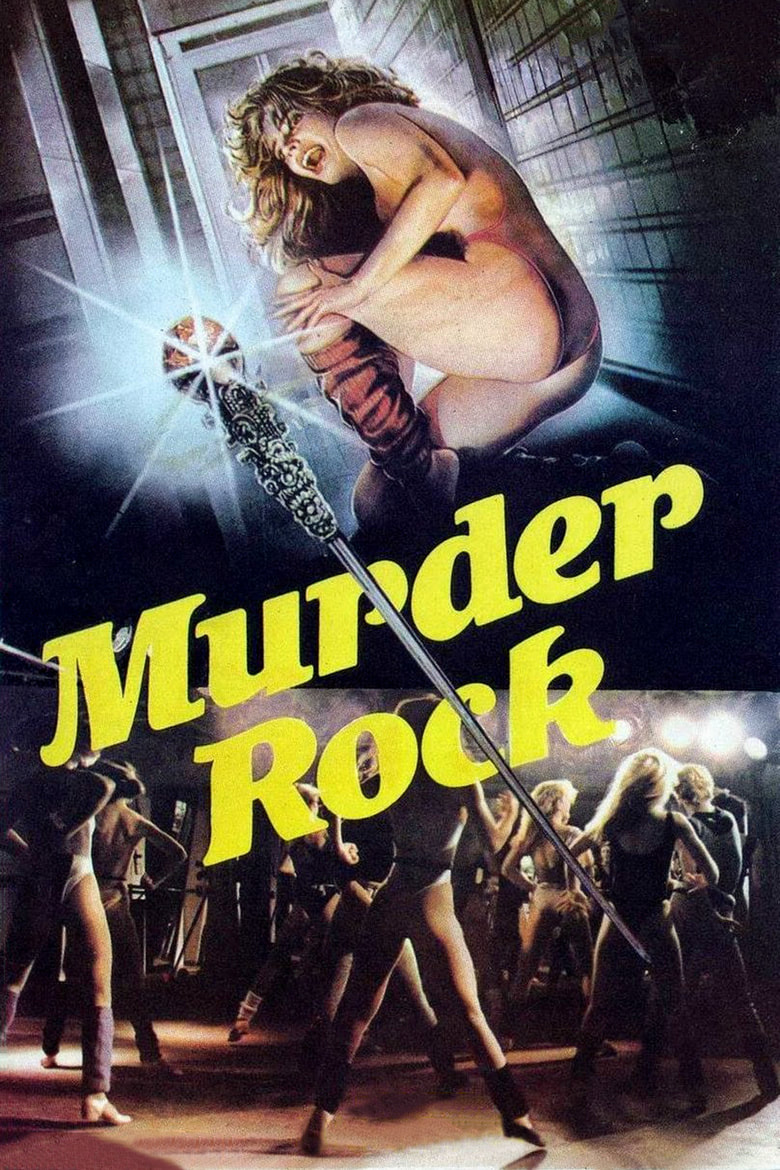Fred and Grace Wright, who look nothing like their names, holiday in Haiti, ostensibly to try and save their crumbling marriage and check in on Fred's old college buddy Williams. Williams has a day job as a doctor, but by night works as a scientist, developing a powerful new hallucinogenic drug which is a target for several interested investors, as well as a black-gloved killer who's offing Williams' assistants and several of his suitors. As Grace becomes enamoured of the island's raw sensuality, her husband's real motivation for visiting the island becomes clear. But is he the mysterious killer, or is it someone else, someone who's a less-obvious suspect? Course it bloody is!
One of the film's failings is actually its lack of suspects; in common with many gialli it slightly over-extends itself with the number of killings, and by the time we come the the big reveal there are very, very few potential suspects. That, added to the presence of a reasonably big-name (and prominently-billed) actor in what appears to be an extremely throwaway cameo kind of tips the film's hat as to the killer's identity. But this isn't really a tightly-plotted thriller; it is, as stated above, a curious mix of influences which is content to do things on its own terms.
There's no real investigative through-line for the audience to latch onto; instead we're kept busy simply piecing together what exactly is going on, and what the characters are really after (the drug McGuffin for all apart from Grace-who wants sex-and Williams-who wants Grace, kind of). Actually, it's difficult to know what exactly Williams wants, as he stalks his way around the island seemingly trying to escape some past trauma which is never expounded. All we really know is that he doesn't need money, and is implacable in the face of death, something he repeatedly displays thanks to his unfortunate habit of finding corpses. That might be a trait he's picked up from the Haitian locals, given the police's apparent lack of interest in investigating the spate of murders, or of giving a shit when Williams reveals that he's been concealing a murder from them.
The past trauma from which Williams is seemingly hiding from is hinted at by some comments by his old college mucker, but the 'revelation' of who Williams really is, as Fred puts it snarlingly to his wife towards the climax of the film, contains no information that we didn't already know, and is surprisingly anodyne. Similarly, is the (SPOILERY) confession by Williams that he discovered his missing colleague Crotz's corpse several days previously supposed to be a shocking revelation? We've seen him (implacably) make the discovery, and it's fairly easy to deduce the identity of the corpse, the later phone calls supposedly made by Crotz notwithstanding. The lack of giallo experience of any of the main creative forces behind the film really shines through in moments such as these. (END SPOILERIES)
The casual approach to the giallo aspects of the film can also be seen by the fact that the first three kills happen offscreen; the first murder we see occurring at the halfway point. It's as if the directors suddenly realised that they needed to spice things up with a few murders, leading to a couple of fairly brutal and drawn-out murder scenes belatedly rearing their heads (this also supposes that the film was shot in order, which is unlikely in the extreme, but hey ho). There are other failings-the plot to entrap the killer makes no sense unless his identity was already known to the architects of said plot, to give one example. And, the revelation that Williams was a dab hand at using a spear gun in his youth which comes literally seconds after we've seen a spear gun murder is so heavy-handed it beggars belief.
The aim when foregrounding characters as suspects should ultimately be to put one over on the audience, and have them suspect the wrong character come the time of the big reveal. To achieve this, you need them to think they're outsmarting the film, and picking up on visual or aural cues which were supposed to bypass them (but which have actually been deliberately planted by the filmmakers, in a kind of double-bluff). If Williams' prowess was hinted at through a half-seen framed photo in his house, for example, or if there was a spear gun glimpsed in the corner of his bedroom, framed in a manner which leads the viewer to suspect that their eagle eye has picked up on some vital info the film was trying to sneak past them, then Williams might have been a viable suspect (setting aside the fact that we've seen the killer spying on him earlier in the film-there could, one supposes, have been two killers working independently). But the clumsy shoehorning in of the spear gun dialogue here has the opposite effect-it's so nakedly obvious an attempt to cast suspicion on Williams , we know straight away that he's innocent.
What the directors*-at least, one of them (Giampaolo Lomi)-were good at was filming documentary footage. The native voodoo rituals are shot with energy and do seemingly capture a sense of authenticity, with Lomi himself (as well as an end credits spiel) stating that they were ceremonies which were staged for the film, but were nonetheless genuine. Given mondo films' propensity for playing fast and loose with the truth it's difficult to fully accept this assertion, but I'm no expert in voodoo, so I can't point to anything specific to debunk it. (The slaughter of the bull in the first, and main, ceremony is certainly, and lamentably, genuine.) One of the main purposes of the ceremony seems to be to showcase as many topless young women as possible-is there any giallo featuring a black woman which doesn't involve an exotic dance sequence?
The veneer of authenticity of the ceremony lends it some credibility, and it's certainly a less egregious display of female flesh than you'd see in many a giallo, but the film does inarguably position the native Haitians as an 'other', denying them any real identity apart from their voodoo rituals and street bazaars. There's nothing necessarily overtly racist in the film (although I suspect that the subtitles on the Camera Obscura DVD may have fudged over a few derogatory terms for black people), but it certainly isn't overflowing with enlightenment, to the point where no native characters are really prominent enough even to be considered suspects for the murders (scientific advancements being, after all, anathema to their earthy way of life). And, there is a certain fetishisation of the young virile black man, but at least that's a variation on the more common fetishisation of the young, sexy black woman. Although given that I'm a proponent of the futility of reading single characters as being representative of groups of people as a whole, maybe it's just that these films happen to showcase the few black people who are into dancing and sex. After all, it's not as if one in, say, seven white males are murderers, is it?
*There's some debate/confusion over who actually directed the film; Lomi claims that Mulargia treated the film as a holiday, only occasionally turning up to supervise goings-on, whereas Mulargia, who's now dead and thus has been denied a right-to-reply to Lomi's comments on the Camera Obscura release, did say previously that Lomi was brought in to film the voodoo rituals in a documentary style, but didn't direct the rest of the film. I'd tend to believe Mulargia, given the difference in style between the 'documentary' sequences and the remainder of the film.



 RSS Feed
RSS Feed
